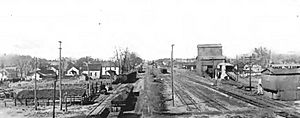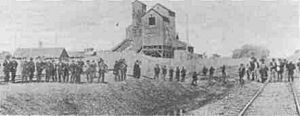Battle of Virden facts for kids
The Battle of Virden was a serious fight that happened in central Illinois on October 12, 1898. It involved coal miners who were on strike and the company that owned the mine. This event was about both workers' rights and racial issues.
Miners from the United Mine Workers of America (UMWA) union were on strike in Virden, Illinois. The Chicago-Virden Coal Company then hired armed guards. They also brought in African-American workers to take the place of the striking miners. When a train carrying these new workers arrived in Virden, a big fight broke out.
Many people were hurt or killed. Eight striking miners and five guards died. Many more were wounded, including some of the new workers. This event was one of several violent conflicts in the area around that time. It showed the strong tensions between workers and companies, and also racial problems. After this battle, Virden became a "sundown town". This meant that African-American people were not allowed to live or stay there after dark. Most black miners were forced to leave Macoupin County.
What Happened at Virden?
Most coal companies in Illinois had agreed to a deal with the UMWA union. However, the Chicago-Virden Coal Company and a few others did not. Instead, they decided to hire African-American miners to work during the strike. These new workers were called strikebreakers.
On September 24, a train carrying potential strikebreakers arrived in Virden. It did not stop and continued north to Springfield, Illinois. There were no problems that day.
The Day of the Battle
On October 12, 1898, another train arrived in Virden. It carried over 100 African-American men, along with their wives and children. The train had brought these workers from Birmingham, Alabama. In East St. Louis, armed detectives from the Thiel Detective Service Company got on the train. They carried Winchester rifles and were ordered to protect the strikebreakers.
The train stopped near the mine. The striking miners tried to surround the train. Then, shooting started from all sides. The new workers and their families on the train were not armed. They hid under the seats as the train's windows were shot out.
Many people were killed or hurt on both sides. Eight UMWA miners died, and 30 were wounded. Four Thiel guards were killed, and five were wounded. Some of the African-American workers on the train were also hurt. After about twenty minutes of shooting, the train's engineer drove away. The train continued north to Springfield.
In Springfield, the injured and dead were taken off the train. UMWA officials promised to help the Alabamians. They were asked to come to the union hall. The next day, the union said they would not help the African-American workers after 6 PM. Some black miners tried to run to the train station but were caught by white miners. A crowd gathered, threatening the strikebreakers. However, Mayor Loren Wheeler of Springfield helped calm the crowd. He arranged for the Birmingham miners to go to St. Louis on the next train. Once there, they were left without money, food, or warm clothes.
Governor Tanner Steps In
Governor John Riley Tanner of Illinois ordered the Illinois National Guard to stop any more strikebreakers from coming into the state. He said he would use powerful guns to stop any train carrying them. A captain in the Illinois Guard at Pana also promised to stop any new workers from arriving.
The governor admitted he might not have the legal right to do this. But he said he was doing what the people wanted. By mid-November, the mine owners gave in. They agreed to let the UMWA union organize the Virden coal mines. The union and the mine owners also agreed to separate the Virden mines by race. Virden continued to be a sundown town for many years. State records show that by 1908, only one African-American miner was left in Macoupin County.
A monument in the Virden town square remembers the coal strike of 1898. It has a large bronze picture that shows the names of those killed. It also shows a copy of a flyer the company used to recruit the new miners. The monument shows the train tracks and the attack on the striking miners. Guards are shown pointing their rifles at the miners and their families. On top of the monument is a bronze picture of Mary Harris Jones, also known as "Mother Jones." Mother Jones is buried near Mount Olive, Illinois, with miners who died in the 1898 conflict.
Other Conflicts
The UMWA union and coal mine owners had similar fights in other towns. These included the Pana Massacre in Pana, Illinois on April 10, 1899. Another was in Carterville, Illinois on September 17, 1899.
Before and after the Virden events, Governor Tanner sent the state militia to Pana. This was to keep peace while miners tried to form a union. After the militia left Pana, white striking miners killed two of their own. They also killed five African-American strikebreakers on April 10, 1899. At least 15 people were wounded.
At Lauder (now Cambria, Illinois), striking miners attacked a group of African-American miners on a train. This happened on June 30, 1899. A woman named Anna Karr was killed, and about twenty other people were hurt. In Carterville on September 17, union miners fought against black strikebreakers. Five non-union miners were killed. Local juries later found all those accused in these attacks not guilty.
About a month after the Virden conflict, a person was harmed in Lacon, Illinois. This happened because they did not follow a new rule in the town of Toluca. There was no strike happening in Toluca at that time.



